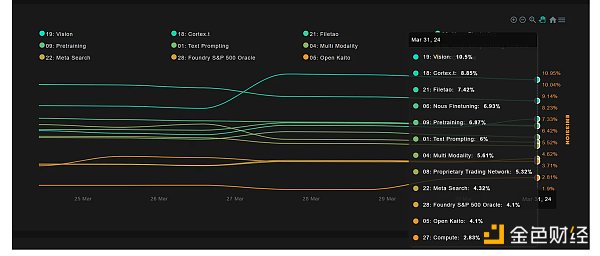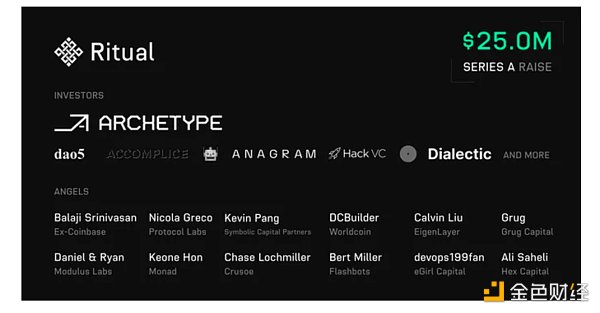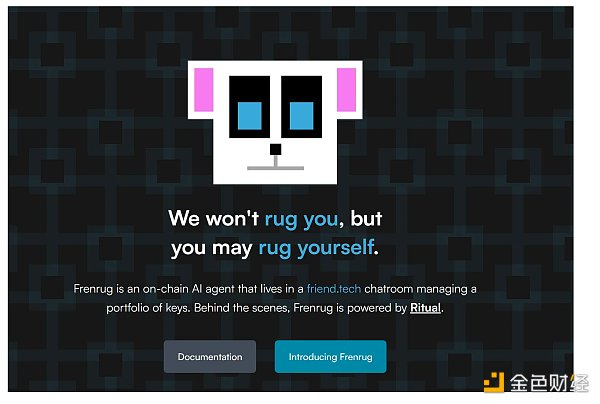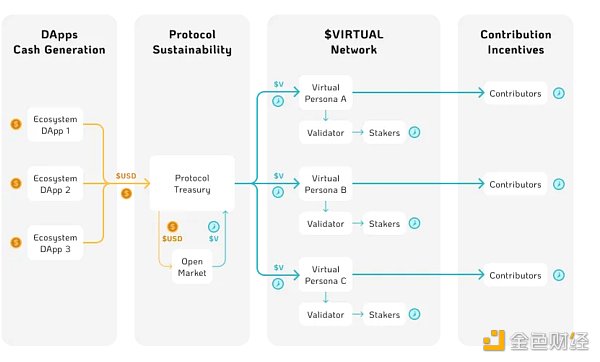ByteDance founder tops China's rich list with a net worth of $350 Billion
ByteDance founder Zhang Yiming has claimed the crown of China’s wealthiest individual
 XingChi
XingChi
Author: LindaBell Source: chainfeeds
In the past year, with the popularization of the concept of decentralized AI and the widespread application of various AI tools, AI + Web3 has gradually become one of the hottest topics in the crypto circle. According to incomplete statistics, there are currently more than 140 projects combining Web3 and AI in the industry, covering multiple directions such as computing, verification, metaverse, and games. Ethereum co-founder Vitalik also wrote an article to discuss the use cases of the combination of blockchain and AI, and pointed out that the cross-field use cases of the two are increasing, and some use cases have higher significance and robustness. In addition, at the "Hong Kong Web3 Carnival" event held recently in Hong Kong, the topic of combining AI and Web3 was frequently mentioned, whether in the main venue or the side venue.
This article selects three Web3 and AI combination projects that are worth paying attention to, and discusses their unique positioning and development prospects in the field of encrypted AI.
In the field of AI, unlike resource-intensive computing power and data, encryption algorithms focus more on technology-intensive work. However, there is a problem in the current AI field, that is, due to the existence of technical barriers, algorithms and models often cannot cooperate effectively, resulting in a zero-sum game situation. In order to change this situation, Bittensor proposed a solution to promote cooperation between different algorithms through blockchain networks and incentive mechanisms, and gradually build an algorithm market for shared knowledge. In short, similar to the Bitcoin mining network, Bittnsor simply replaces the Bitcoin mining calculation process with training and verifying AI models.
From the name, "Bittensor" can be decomposed into two parts: "Bit" and "Tensor". Bit is familiar to us. It can be understood as the smallest unit of currency in Bitcoin. In a broader sense of computer science, Bit represents the most basic unit of information. "Tensor" comes from the Latin word "Tendera", which originally means "extension". In physics, Tensor refers to a tensor with multiple indices, a multidimensional array or matrix that can represent various types of data. In the field of machine learning, Tensor means for representing and processing multidimensional data.
The architecture of Bittensor can be divided into two layers. The bottom layer is a blockchain based on Polkadot Substrate, which is responsible for executing the consensus mechanism and incentivizing the network. The AI layer is responsible for reasoning, training, and ensuring input/output compatibility between Bittensor protocol nodes. The Bittensor network has two key participants, namely miners and validators. Miners submit training models to the network in exchange for token rewards, while validators are responsible for confirming the validity and accuracy of the model output and selecting the most accurate output to return to users. In order to create a positive competition cycle, Bittensor implements incentive distribution through the Yuma consensus mechanism. Yuma consensus combines the two mechanisms of PoW and PoS, in which miners obtain token rewards by competing for calculation results, while validators need to stake their tokens on a subnet and complete the verification work to obtain a certain amount of TAO incentives. The more accurate and consistent the screening and evaluation of AI models, the more rewards they will receive.
Subnets are a core component of the Bittensor ecosystem. In October 2023, Bittensor introduced the concept of "Subnet" through the Revolution upgrade. Different subnets can be responsible for different tasks, including machine translation, image recognition and generation, language large models, etc., and these subnets can interact and learn from each other. Anyone can create a subnet on Bittensor, but they will need to pay a fee in TAO tokens, which depends on the supply and demand of subnets on the network. In addition, they will need to run tests locally and on testnets before launching the subnet on the mainnet.
There is currently one special subnet on Bittensor, 0# Root, and 32 other subnets. 0# Root was built by the Opentensor Foundation and serves as the governance center on Bittensor, able to distribute the produced TAO to other subnets through consensus. On 0# Root, the role of validator comes from the top 64 validators with the most stakes on other subnets, and the role of miner is played by other subnets. In addition, 0# Root can also allocate incentives to other subnets based on the amount of contribution. For the remaining 32 subnets, validators and miners will receive a certain proportion of TAO based on their respective contributions. Typically, 41% goes to validators, 41% goes to miners, and the remaining 18% goes to subnet creators. The competition between subnets in the Bittensor ecosystem is very fierce. Currently, the maximum number of subnets allowed by the system is 32, but there are already more than 200 subnets in the testnet waiting to be registered on the mainnet. Recently, some outstanding teams have also registered their own subnets on Bittensor, such as MyShell TTS. According to the subnet registration rules, once the upper limit of the number of subnets is reached, the system will automatically cancel the subnet with the lowest token allocation.

Bittensor has also recently been questioned about its registration fees and practicality. It is reported that the current cost of registering a subnet on Bittensor is 2078.49 TAO, and on March 1 it reached 10,281 TAO, equivalent to more than 7 million US dollars. And as the price of TAO rises, the registration fee may increase further. And every time a project registers a subnet, the registration fee will double, and if no one registers, the price will be linearly halved within four days. For developers who want to create or participate in subnets, the high registration fee will undoubtedly become a huge burden. In addition, the practicality of the Bittensor subnet has also been questioned. Of the 32 subnets, most are low-threshold scenario applications such as "data sorting" and "text, image and audio conversion". And among the teams building on Bittensor, no team has more than a dozen full-time members, and most have only 2 to 3 people. Eric Wall, the founder of the Bitcoin Ordinals project Taproot Wizards and the Bitcoin NFT project Quantum Cats, also expressed his views on the social platform, believing that Bittensor is just a meaningless decentralized experiment that does not provide any practicality. Eric Wall pointed out, "Subnet #1 is described as a text prompt service. But in fact, its working mode is very simple. The user sends a prompt and the miner responds, similar to ChatGPT. Miners participating in this process will receive TAO tokens as rewards. But there is serious redundancy here, because the validator only checks the similarity of the answers. If a miner's answer is different from others, he will not get a reward. The entire system is extremely inefficient and cannot effectively verify whether the model is actually run. In addition, as an ordinary user, it is impossible to interact with the network at all. The only purpose of the entire subnet seems to be internal operation. This process looks like buying useless AI tokens to gain exposure to decentralized AI."
There are many problems in the existing AI stack, including the lack of protection for computational integrity, privacy, and censorship resistance. In addition, infrastructure hosted by a few centralized companies also limits the local integration capabilities of developers and users, leading to effectiveness issues. In this context, the decentralized AI computing platform Ritual came into being.
Ritual's main goal is to provide an open and modular sovereign execution layer for artificial intelligence, that is, how to introduce artificial intelligence into EVM, SVM and other virtual machine environments. In short, Ritual connects distributed node network computing resources and model creators, allowing creators to host their AI models, while users can add the full reasoning capabilities of AI models to their existing workflows in a verifiable way.
Ritual has a very strong team background, and co-founders Niraj Pant and Akilesh Pott were once general partners of Polychain. In addition, team members also include senior engineers from well-known companies such as Microsoft AI and Facebook Novi, and professionals from well-known institutions such as Dragonfly, Protocol Labs, and dYdX. In addition, Ritual's advisory lineup is also very impressive, including EigenLayer founder and partner Sreeram Kannan, Gauntlet founder and CEO Tarun Chitra, and BitMEX co-founder Arthur Hayes.
So far, Ritual has completed two rounds of financing. In November 2023, Ritual announced the completion of US$25 million in financing, led by Archetype, ccomplice, Robot Ventures, dao5, Accel, Dilectic, Anagram, Avra and Hyperspher and angel investors Coinbase former CTO Balaji Srinivasan, Protocol Labs researcher Nicola Greco, Worldcoin research engineer DC Builder, EigenLayer Chief Strategy Officer Calvin Liu, Monad co-founder Keone Hon, AI+Crypto project Modulus Labs' Daniel Shorr and Ryan Cao participated in the investment. On April 8, 2024, Ritual received a multi-million dollar investment from Polychain Capital. The specific amount is not yet known.

Currently, Ritual has launched Infernet, a lightweight library that brings computation to the chain, allowing smart contract developers to request computation off-chain through Infernet nodes, and pass the computation results to smart contracts on the chain through Infernet SDK. Infernet nodes are lightweight off-chain clients of Infernet, mainly responsible for listening to on-chain or off-chain requests, and delivering workflow outputs and optional proofs through on-chain transactions or off-chain APIs. The Infernet SDK is a set of smart contracts that allow users to subscribe to the output of off-chain computational workloads. One of its main use cases is to bring machine learning reasoning to the chain. Infernet can be deployed on any chain, allowing any protocol and application to be integrated. In addition, Infernet also allows developers to introduce their own proof systems, including Halo2 validators and Plonky3 validators.
Infernet does not perform reasoning directly on the chain, but is similar to an oracle system, where requests are made on the chain, and off-chain nodes execute and return the corresponding information to the chain. However, this method also has asynchronous problems, that is, developers need to wait on the block after making a request and cannot get an immediate response. Ritual's approach is to allow developers to perform reasoning operations directly in their familiar environment without worrying about where the operations occur. Although these operations are still performed off-chain, by embedding these computational operations in the virtual machine, each node can perform ultra-optimized artificial intelligence operations while running a modified virtual machine. This method can be seen as a form of interactive communication, which is achieved through precompilation. The emergence of this method is also a development trend of the blockchain ecosystem.
In terms of specific implementation, through Infernet, developers can delegate computationally intensive operations to the off-chain, consume outputs and optional proofs in smart contracts through on-chain callbacks, and circumvent the limitations of the smart contract execution environment. For example, Emily is developing a new NFT collection that allows minters to add new features to NFTs independently. Emily built a minting website and published the signed delegation to an Infernet node running a custom workflow that can parse user input and generate new images, and the Infernet node sends the final image to her smart contract through on-chain transactions.

At the end of 2023, Ritual released an application powered by the Infernet SDK, Frenrug. Frenrug is a chatbot running in the Friend.tech chatroom, and any user holding Frenrug's Key can send messages to Frenrug. For example, you can buy or sell the corresponding friend.tech user's Key through Frenrug, but Frenrug does not process user messages directly, but sends messages to multiple Infernet nodes, which run different language models. Infernet nodes process user messages and generate votes on the blockchain. When enough nodes vote, the system aggregates these votes and performs corresponding operations on the blockchain, such as buying or selling Key. Finally, Frenrug will reply in the chat room, including the voting results and final operations of each node, so that users can understand how the system handles their requests.

Ritual is currently developing its second product, "Sovereign Chain Ritual Chain". While Infernet can be easily integrated into any EVM chain, making it available to any protocol, Ritual still believes that building a chain is necessary because it allows for more efficient functionality on the core execution and consensus layers, and allows users who want to maximize the value of AI to the protocol to realize their vision. Of course, in order to achieve a sovereign chain, Ritual needs to build different types of validators, proof systems, and various complex functions, and it needs to be simple enough for users to easily get started.
Unlike Bittensor and Ritual, which interact with various machine models, Virtual Protocol is like a decentralized factory focused on creating AI characters for various virtual worlds. It focuses more on user participation and incorporates human subjective ideas and social consensus into its vision to promote personalization and immersion. The core idea of Virtual Protocol is that future virtual interactions will be enabled by artificial intelligence and built in a decentralized way to provide personalized and ultra-immersive experiences. Among them, personalization ensures that each interaction can establish a personal connection with the user, making it uniquely relevant. On the other hand, immersion can stimulate users' various senses and create a more realistic experience.

Virtual ecosystem participants include contributors and validators. Contributors can provide various text data, voice data, and visual data for the model, whether it is the improvement of existing models or the proposal of new models. These are reviewed and certified by validators for accuracy and authenticity, and the quality of their contributions is assessed to ensure they meet the standards set by the Virtual Protocol ecosystem.
New Proposals:Anyone can initiate the creation of Genesis Virtual, but they need to stake at least 100,000 VIRTUAL within a specified three-month period and pass the DAO proposal process. All token holders in the Virtual community can vote on the proposal. Once the proposal is passed, a new Virtual NFT will be minted.
Contributing to Existing Models:Proposals are automatically generated and reviewed, discussed, verified, and voted on by validators for changes.
Currently only validators have the right to verify or vote on proposals, and the entire verification process is anonymous. Validators need to interact with each pair of models for at least 10 rounds. After completing the verification task, the validator can receive a staking reward that matches the total staking ratio of his representative. To become a validator, the user must hold 1,000 Virtual tokens in the Virtual account and commit to verifying all proposals. In addition, Virtual adopts the DPos mechanism. If you want to get staking rewards without verification, you can choose to entrust any amount of tokens to the Virtual validator. The validator will return the staking reward to the entrusting user after deducting 10% of the income ratio.
Virtual's entire participation process is transparent and recorded through the public blockchain. All contributions will be converted into NFTs and stored in the Immutable Contribution Library (ICV) to ensure its traceability and fair distribution of rewards. The Immutable Contribution Library (ICV) is Virtual's multi-layer on-chain repository, which archives all Virtual-approved contributions on the chain, presents the current status of each Virtual, and tracks its historical evolution. In addition, ICV creates a transparent environment through the open source VIRTUALs codebase model. It promotes composability, allowing developers and contributors to build on and seamlessly integrate with existing VIRTUALs.
Virtual tokens are the core of the Virtual protocol, and their main functions include rewarding contributors and validators, supporting protocol development, and airdrops. The total supply of Virtual tokens is 1 billion, of which 60% are already in public circulation, 5% are reserved for liquidity pools, and the remaining 35% are dedicated to community incentives and initiatives for the development of the Virtual protocol ecosystem. In the next three years, the annual release will not exceed 10%, and deployment must be approved by the management department.
The Virtual protocol achieves flywheel drive through revenue and incentives. Revenue comes from the use of various dApps, and dApps need to pay usage fees to the protocol. At the end of each month, the Virtual protocol will distribute incentives based on the total revenue inflow of dApps, 10% of which will be allocated to the protocol, and the remaining 90% will be distributed among the various Virtual applications according to the staking ratio to ensure that the income is proportional to their contribution. For example: the total inflow income is $100, of which $10 will be allocated to the protocol. Of the remaining $90, since Virtual A's staking pool has 9,000 tokens and Virtual B's staking pool has only 1,000 tokens. Then Virtual A will receive 90*90%=81 US dollars, and Virtual B will receive 90*10%=9 US dollars.
In each Virtual application, the income will be evenly distributed to validators and contributors. Validators will receive income based on running time and staking amount, where running time refers to the ratio of the number of verified proposals to the total number of proposals. For example, if the running time of validator A in Virtual A is 90%, it will receive 81/2*90%=36.45 USD. The income will then be further distributed to the stakers, and the specific distribution will be based on the amount. In addition, a default 10% will be paid to the validators of the pool as a delegation fee. Contributors will receive income distribution based on contribution utilization and influence pool. Among them, contribution utilization takes into account the length of time that the contributor's contribution is actively used in the system. Contributors who develop and maintain models will receive 30% of the total distributed income, while users who provide and maintain datasets for model fine-tuning will receive 70% of the total distributed income. In addition, the influence pool awards points based on the importance of the contribution.

Currently Virtual has been connected to a virtual companion game called AI Waifu. The story of the game takes place in a world called "Arcadia". In the game, as a magician in Arcadia, you need to fight against other magicians and their Waifus. You can choose to have a conversation with your Waifu to deepen the connection, unlock hidden stories, and give gifts to get more rewards. Currently, there are three different Waifu to choose from in the game, each with a unique background story and personality. In addition, the game introduces a battle mode where you can seduce other Waifus and protect your own Waifu. All in-game expenditures will go into the game's reward pool, and 60% of WAI transaction fees will also be allocated as part of the reward pool.
Unlike other AI companions and chatbots, AI Waifu is visually presented as a 3D model and can react to sounds and text with emotions and animations. By communicating with AI Waifu, she does not repeat the content style, but constantly learns and gives players personalized responses. In addition, AI Waifu is a cross-platform PWA with a crypto-enabled economic design that allows for co-ownership and returns its expenditures to developers as a share of revenue.
In addition to AI Waifu, Virtual also plans to launch a new type of AI RPG with cross-game memory and ultimate consciousness. These AI agents are able to dynamically evolve by interacting with in-game players and other agents. That is, users can put the agent into game A for training and retain the training memory. Later, when the agent is placed in game B, the memory of game A is still retained. Through continuous learning, AI agents can imitate the behavior of human players and can be dynamically constructed according to player behavior and game environment changes, which can make the user's gaming experience richer and more personalized, even including unpredictability. Users can also upload interaction records to obtain token rewards. In addition, Virtual also plans to launch a virtual idol that can be broadcast live on any platform.
In the field of encrypted AI, Bittensor, Ritual and Virtual Protocol are deeply involved in different fields. Among them, Bittensor is committed to building an algorithm market for sharing knowledge, and its market value currently occupies a leading position in the field of encrypted AI. However, community members have recently raised some questions about the registration fee and practicality of its subnets. However, whether the problems of a single subnet can be attributed to the defects of the entire network needs to be evaluated. In addition, regarding the problem that the system relies heavily on validators to run, Opentensor Foundation contributors recently proposed a dynamic TAO solution "BIT001".
With its strong financing lineup and team background, Ritual has become a new player in the encrypted AI track. Previously, Dragonfly partner Haseeb Qureshi said in an article that the cryptoeconomics adopted by Rutial is the simplest and possibly the cheapest in the verifiable inference track, but there are security issues with node collusion. However, Ritual Lianchuang later explained on the social platform that the Ritual platform did not adopt a cryptoeconomics approach based on node cooperation and selective collusion, but provided users with the option to choose the level of security according to their preferences.
In contrast, Virtual Protocol is more interesting and focuses on user participation. For example, the protocol launched the AI Waifu virtual companion game and the upcoming game AI agent. Compared with the established rules of traditional games, Virtual Protocol is committed to establishing interactive relationships with players, and hopes to dynamically evolve according to player behavior and the game environment, thereby increasing the social attributes and continuity of the game.
Of course, in addition to the three projects mentioned in this article, there are many Crypto AI projects on the market that are worth paying attention to, such as io.net, which focuses on the GPU rental market, the AI proxy protocol Autonolas, and the Web3-enabled AI platform MyShell, which focuses on creators. These projects all demonstrate the diversity and potential of the Crypto AI field, and we will continue to pay close attention to the development of this field.
ByteDance founder Zhang Yiming has claimed the crown of China’s wealthiest individual
 XingChi
XingChiBeeple is an American graphic designer, digital artist, and animator, known for making comical and often surreal multimedia works with social and political messages. Beeple has a net worth of $50 million.
 Pr0phetMoggy
Pr0phetMoggyAmong his early NFTs, "Crossroad," a commentary on the 2020 U.S. presidential election, made headlines by selling for $6.6 million in February 2021.
 Brian
Brian Coinlive
Coinlive HNW investors continue to be interested in investing directly straight into the asset class.
 Finbold
FinboldRecently, the White House released a report that details how crypto mining and other technologies contribute directly to pollution, greenhouse gas effect, noise, and other hazardous environmental effects.
 Bitcoinist
BitcoinistWealth managers are being advised to prioritize education and advice after a new survey reveals that most of the world's wealthiest individuals are invested in digital assets.
 Cointelegraph
CointelegraphA new survey suggests that most of the world’s wealthiest have invested in digital assets and wealth management firms have been advised to prioritize providing education and advice.
 Cointelegraph
CointelegraphCryptocurrencies play a major part in wealthy people's way of life. A recent survey reveals that global high-rollers are spending ...
 Bitcoinist
Bitcoinist"We are going to become the first city in the world to mine Bitcoin here on site at city hall," said Fort Worth Mayor Mattie Parker.
 Cointelegraph
Cointelegraph